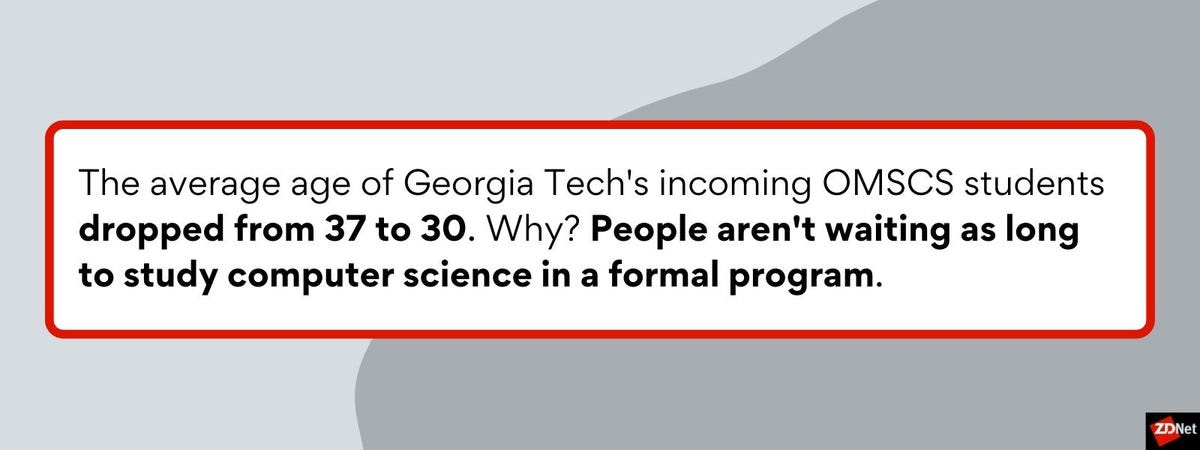What’s behind the success of post-grad computer science programs?

[ad_1]
Online learning isn’t a new idea. It’s rooted in correspondence courses. Back in the late 1800s, postal mail services powered learning and communication platforms. Today, it’s all digital, with teacher-student interaction available in real-time and on your own time.
The ongoing pandemic prompted people to reconsider their career outlook. As a result, many people decided to expand or refresh their education. In response, colleges enhanced existing online learning options and introduced new programs.
‘It was a risky endeavor’
Atlanta-based Georgia Tech says it was the first accredited university to offer an online master of science in computer science, or OMSCS for short. The degree is available in a massive online format. Georgia Tech partnered with Udacity and AT&T to launch its OMSCS program in 2014.
For the spring 2022 semester, 12,016 students enrolled in the program. For the fall 2021 semester, 837 people graduated. Nearly 6,500 students have graduated so far.
David Joyner, Ph.D., is the executive director of online education and OMSCS at the College of Computing at Georgia Tech. Joyner pointed to four key factors that contributed to the success of the OMSCS program.
“Hindsight makes the success of OMSCS seem like a foregone conclusion, but at the time, it was a risky endeavor,” Joyner said. “The low tuition could have undermined our on-campus program enrollment, and the high admission rate could diminish the perceived quality of the degree.”
But the opposite happened. In less than a decade, the OMSCS program’s reputation and visibility have driven more applications to the on-campus program. Joyner feels the online students’ “incredible quality” has improved the college’s reputation.
Joyner credited the willingness of the program’s founders and visionaries — along with Georgia Tech’s administrative leaders — to move forward despite the risks of starting something new.
In addition, “the faculty embraced the idea of building the online program and making sure it adhered to the standards we have come to expect on campus,” Joyner said. “The courses are taught by the same professors who teach in person and who do the research that then becomes material for their classes, and that provides an authenticity that gives the program its magic.”
Once the program enrolled more than 2,000 students, Joyner and his colleagues realized they couldn’t support the program’s growth with only on-campus teaching assistants.
“But online students have stepped up in droves to support the program,” Joyner said.
Now the program employs over 400 teaching assistants, almost half of whom are alumni. Many are now professionals working in the field. As a result, their firsthand professional experience, perspectives, and insight improve the courses they’re supporting, according to Joyner.
Finally, Joyner said, technology “recently reached a point where rich, authentic, active learning experiences and dynamic social learning communities can be created and scaled around the world with relative ease.”
Job scarcity driving student interest
Georgia Tech claims to be the first. But today, dozens of colleges offer online-only post-grad computer science programs. They include the University of Texas at Austin, which launched its master of computer science online (MCSO) degree in 2019.
Eric Busch, Ph.D., is the director for online programs in computer science and data science at UT Austin. He said the tech job market is a factor making this kind of master’s in computer science worth it for many students.
“The effects of the pandemic notwithstanding, we believe that MCSO’s early success is rooted in the stark disparities of the education and labor markets in computer science fields — which the program is in part designed to address,” Busch said.
The gap between the number of computer science graduates and the number of open computing jobs is well documented. That scarcity creates massive unmet demand for skilled CS workers in a wide variety of areas and job functions.
— UT Austin’s Eric Busch
The Society for Human Resource Management predicted employers would struggle to find and keep IT workers in 2022. About three months into the year, SHRM’s prediction appears to be coming true.
“The gap between the number of computer science graduates and the number of open computing jobs is well documented,” Busch continued. “That scarcity creates massive unmet demand for skilled CS workers in a wide variety of areas and job functions. Although companies in the tech space have raised salaries to compensate, the supply of skilled labor in these fields remains relatively inelastic.”
Busch said that inelasticity is rooted in educational scarcity. Even large on-campus computer science programs like UT Austin’s can only accommodate so many in-person students in any year.
“On-campus capacity remains limited in terms of financial aid capacity and physical space,” Busch said.
For the spring 2022 semester, UT Austin had 860 students enrolled in the MCSO program. UT Austin faculty teach the courses, which feature lessons designed for online learning.
“Programs like MCSO represent an important intervention in this dynamic of scarcity,” Busch added. “Because our online, asynchronous curriculum format can handle much higher volumes of students, we are able to admit all applicants who are qualified and capable of earning a master’s degree.”
Content changes part of program success
We’ve operated for the past two years with no online program manager or MOOC partner, and I think we’ve been better off for it as it lets us design every element of the program to our own needs.
— Georgia Tech’s David Joyner
Joyner says academic content shifts also contribute to the OMSCS program’s success.
When the program started, OMSCS partnered with a massive open online course provider that produced and hosted the school’s course content.
“Now, we handle production ourselves and host content on our own platforms,” Joyner said. “We’ve operated for the past two years with no online program manager or MOOC partner, and I think we’ve been better off for it as it lets us design every element of the program to our own needs.”
“Our early classes were relatively lecture-heavy, and while they used a lot of active learning strategies, there was a major focus on the prerecorded video content,” said Joyner. But now, he said, online M.S. in computer science courses are instead built around six focal points:
- Classes with minimal lecture content built around open-ended, student-driven projects
- Lab-based challenges and simulation-based evaluation
- Synchronous workshops with faculty and teaching assistants
- Seminars focused on student presentations or shared reading interests
- Classes based on partnerships with real-world non-profits or healthcare professionals
- Independent student research in partnership with faculty
What’s the outlook beyond this year?
In application cycles since the pandemic started, applications for Georgia Tech’s OMSCS were up 14%.
Joyner suspects the increase in applicants to this online post-graduate program in computer science is temporary. He thinks students are attracted to affordable online education at a time when “there is so much uncertainty around personal finances, global economics, and public health.”
Joyner also highlighted a noteworthy demographic shift at Georgia Tech. The average age of incoming OMSCS students has dropped from 37 to 30.
That likely indicates “we are drawing more students early in their careers and fewer mid-career professionals who have been waiting more than 15 years for an opportunity to study CS in a more formal program.”

Tori Rubloff/ZDNet

“That said,” he continued, “we have been wrong before: We thought we had stabilized in the first three years of the program, only to see explosive growth after that.”
Busch, at UT Austin, also has a positive outlook for post-grad computer science education.
“We anticipate continued enrollment growth in both the MCSO program and in online graduate education in general,” he said. “MCSO continues to add new courses, and expects to remain among the market leaders in online computer science education based on its use of tenured faculty to teach online courses, and its focus on rigor and building student community.”
This article was reviewed by Monali Mirel Chuatico

In 2019, Monali Mirel Chuatico graduated with her bachelor’s in computer science, which gave her the foundation that she needed to excel in roles such as data engineer, front-end developer, UX designer, and computer science instructor.
Monali is currently a data engineer at Mission Lane. As a data analytics captain at a nonprofit called COOP Careers, Monali helps new grads and young professionals overcome underemployment by teaching them data analytics tools and mentoring them on their professional development journey.
Monali is passionate about implementing creative solutions, building community, advocating for mental health, empowering women, and educating youth. Monali’s goal is to gain more experience in her field, expand her skill set, and do meaningful work that will positively impact the world.
Monali Mirel Chuatico is a paid member of the Red Ventures Education freelance review network.
Last reviewed March 21, 2022.
[ad_2]
Source link







